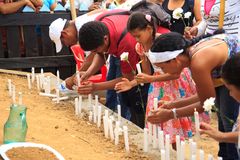
Everything changed for the victims’ families after their loved ones were forcibly disappeared. Their livelihoods were destroyed.
Twenty-two years after the forced disappearance of 43 villagers from Pueblo Bello (Turbo, Antioquia), their family members organized a commemorative event of courage and solidarity. The purpose: to honour the memory of their loved ones, to strengthen themselves as a community, and to remain united in their unending struggle for justice, memory, and the truth about this tragedy.
Pueblo Bello is located in the Antioquia portion of Urabá amid rolling green mountains covered in native vegetation. It is a village of farming families without paved roads, where horse and mule are still the main means of transportation. Urabá, an area of immense biodiversity, lush vegetation, and huge natural riches, has sadly been the centre of much violence.(1) Guerrillas and paramilitaries have fought over these lands so that they might control both licit economic activities—such as wood, grain, and banana harvesting—and illicit ones - drug, weapons,(2) and human trafficking,(3) among others. Unfortunately, the civilian population has been most affected, as they have been trapped in the middle of the internal armed conflict that has terrorized Colombia for more than 40 years.
And so it was that on the night of 14 January 1990, approximately 60 paramilitaries from the group ‘Los Tangueros,’ under orders from Fidel Castaño, arrived in Puerto Bello and forced the villagers to come out of their homes and the church. They took them to the central plaza and made them lie face down, then selected 43 villagers, three of them children. They gagged those 43 and took them away. The vehicles that the paramilitaries transported them in passed through two military checkpoints without being stopped or asked to show identification of any kind. They were taken two hours away to a farm in the Department of Córdoba where they were received by Fidel Castaño, interrogated, and tortured. In its 31 January 2006 decision, the Inter-American Court of Human Rights recounted the details: “During these interrogations, they severed the veins, ears or genital organs of some of those abducted, or they gouged out their eyes… the survivors were ‘kicked and beaten’ to death.”(4)
The reason for this barbarity? The guerrilla had stolen 43 heads of cattle belonging to Fidel Castaño that had been transported through Pueblo Bello. The paramilitary leader considered the villagers to have been either authors or accomplices to the theft.(5)
“The victims were innocent, they had nothing to do with the conflict. They [the paramilitaries] lost 43 animals and took 43 villagers. The animals that they lost were more important to them than the human lives they took; they put more value on the animals than on the human lives,” recalls Sofía del Carmen Macea Álvarez, wife of Wilson Uberto Fuentes Miramón, one of the disappeared.
Everything changed for the victims’ families after their loved ones were forcibly disappeared. Their livelihoods were destroyed. Some fled out of fear; others stayed and endured the anguish and pain; but meanwhile, paramilitary activity flourished in the region. What follows are testimonies from family members recounting the last 22 years:
“The years have been very hard because he was a very important person in our family; a human being, a blood brother, a really incredible person. Those times when one gets together with his entire family and there is one member missing, it is very terrible.” Adalberto Montes, brother of Manuel de Jesús Montes Martínez.
“As one grows, one feels this emptiness over and over, each day more and more.” Adalberto Montes.
“It is if everything has been severed, as if they arrived and cut the wings off a little bird that wants to fly and do many things. For the family it was very hard, horrible, and horrific. My mother thought at one point that it was better to leave it be. In fact, to this day we do not know what happened, and we continue with this uncertainty of not knowing whether or not we will find them, or if we are going to be able to give them a Christian burial. There are many things that are still unclear after 22 years.” Adonai Durango Moreno.
“He was the one who took care of us, and our anguish is the same now as it was then. The children had to start working and stop doing what they wanted to do, like get their high school diploma.” Sofía del Carmen Macea Álvarez.
Despite the suffering, the family members have maintained an unwavering struggle to find the remains of their loved ones, to learn the truth about what happened, and to prosecute those responsible. Of the 43 disappeared, only six have been found and have yet to be clearly identified.(6) Of the 60 paramilitaries who participated in the massacre, only six have been convicted. No members of the Colombia Armed Forces have been convicted, despite findings by the Inter-American Court of Human Rights (IACoHR) that there was enough evidence to prove that the trucks used to transport the kidnapped crossed through a designated “emergency and military operations” zone, in which there had been a checkpoint that, at that time, should have prevented all vehicles from passing.(7)
The day after the forced disappearance, when the families went to the San Pedro de Urabá military base to ask for information about the whereabouts of the kidnapped, Lieutenant Rincón Pulido said that the trucks that transported them had not passed through the military checkpoint and remarked that the residents of Pueblo Bello “had exchanged people for cattle,” alluding to the animals that had been stolen from Fidel Castaño.(8)
The Court´s sentence
After years of fruitless searching and endless proceedings before different authorities and national courts searching for truth and justice that wouldn’t come, representatives of the victims denounced the incidents before the Inter-American Commission on Human Rights (IACHR).(9) On March 23, 2004, the IACHR referred the case of the Massacre of Pueblo Bello to the IACoHR, alleging that “the disappearance of 37 [people], as in the case of the extrajudicial execution of six villagers from Pueblo Bello in January 1990 was an act of private justice at the hands of paramilitary groups led at the time by Fidel Castaño in the Department of Córdoba, carried out with the acquiescence of agents of the State. Because of its magnitude and the [supposed] terror that this created among the civilian population, this episode solidified paramilitary control in this area of the country.”(10)
In January 2006, the Inter-American Court found the Colombian State guilty of violating the right to life, personal integrity, legal protections, and freedom. The Court ordered: (i) the investigation and sanction of all those responsible; (ii) the search for and identification of all victims; (iii) medical and psychological treatment; (iv) a public act of apology and recognition of responsibility; (v) construction of a monument to commemorate the events; (vi) publication of the sentence; (vii) damages payments; and (viii) a housing program(11).
Alejandro Malambo, a lawyer with the Colombian Commission of Jurists says, with regard to complying with the sentence, “very few of these measures have, in reality, actually been carried out. The only one has been the public act of apology and amends that happened about three years ago. But there have been few to no advancements in the more substantial measures. It should be noted, however, that four more paramilitaries were convicted after the sentence.”(12)
This commemoration organised by the victims’ families is important in light of the lack of compliance with the sentence. José Daniel Álvarez, son of José del Carmen Álvarez Blanco, one of the disappeared, is part of the Coordinating Committee formed to organise the event; Peace Brigades International has accompanied him since 2005. Over the years, PBI has been with him throughout his tireless work and dedication to determining the whereabouts of the victims and that justice is done. This is why being with him at this commemoration marks a milestone in this sad history. Mariana Sáenz, a psychologist with the Connections Corporation,(13) reflected on the significance of this commemoration: “It is a symbol of recovering autonomy, of the possibility to make decisions, to manage things on their own, and to do the things that they think are most important.”(14)
The commemoration began with an ecumenical ceremony in the Pueblo Bello church after some opening words from José Daniel and members of other organisations present in solidarity with the cause. Family members cried as he names of each of the 43 disappeared were read aloud, a photo was projected, and a brief description of EACH was read: who they were, what they did, and what they liked.
The families left the church with flowers and lit candles in hand, walking towards the Wall of Memory after a concluding prayer given by Jesuit priest Javier Giraldo, who made a call for memory and solidarity. The Wall was built to honour the memory of the disappeared villagers and was sponsored and constructed by the family members themselves. The faces of the disappeared were drawn on the wall amidst images of other things commonly found in the region like mountains, cornfields, horses, and Bonche flowers.
The participants then held a moving ritual in front of the Wall to call forth the elements of Earth, Light, Water, and Flowers. For the element of Earth, they read an indigenous Nasa text about Mother Earth; for Light the family members lit candles and placed them at the foot of the Wall; for Water Father Giraldo used a flower to anoint with holy water the faces drawn on the Wall; and finally for the element of Flowers the families threw white flowers at the wall. All the while, families were crying, hugging, sharing, and supporting each other.
To end the commemoration, those present had the opportunity to put the last touches of paint on the drawing of their family members’ faces, afterwards placing rocks with their names on them at the bottom of the Wall. Jose Daniel ended the commemoration with a final declaration in which the families asked the Colombian State to comply with the Inter-American Court sentence.
1 “Urabá: violence and territory in contemporary history,” ColomPBIa, no. 16, September 2010.
2 “Bloque Elmer Cárdenas de Urabá,” Verdad Abierta, 3 October 2011.
3 “Tráfico de personas en el Urabá antioqueño,” La Opinión, 13 June 2011.
4 “Inter-American Court of Human Rights, Case of the Pueblo Bello Massacre v. Colombia, Judgment of 31 January 2006,” P.51, Par. 95.40.
5 Ibid. P.48, Par. 95.31.
6 Interview with Alejandro Malambo, lawyer with the Colombian Commission of Jurists, Pueblo Bello, 14 January 2012.
7 Ibid.
8 Sentence of the Inter-American Court of Human Rights, Op. cit., P.50, Par. 95.42.
9 Those representing the victims are the Colombian Commission of Jurists, the Association of Families of the Detained and Disappeared, and the Centre for Justice and International Law.
10 Sentence of the Inter-American Court of Human Rights, Op. cit., P.2, Par. 2.
11 Sentence of the Inter-American Court of Human Rights, Op. cit.
12 Alejandro Malambo, Op. cit.
13 Non-governmental organisation providing psychological support to victims of violence in Colombia.
14 Interview with Mariana Sáenz, Pueblo Bello, January 14, 2012.
